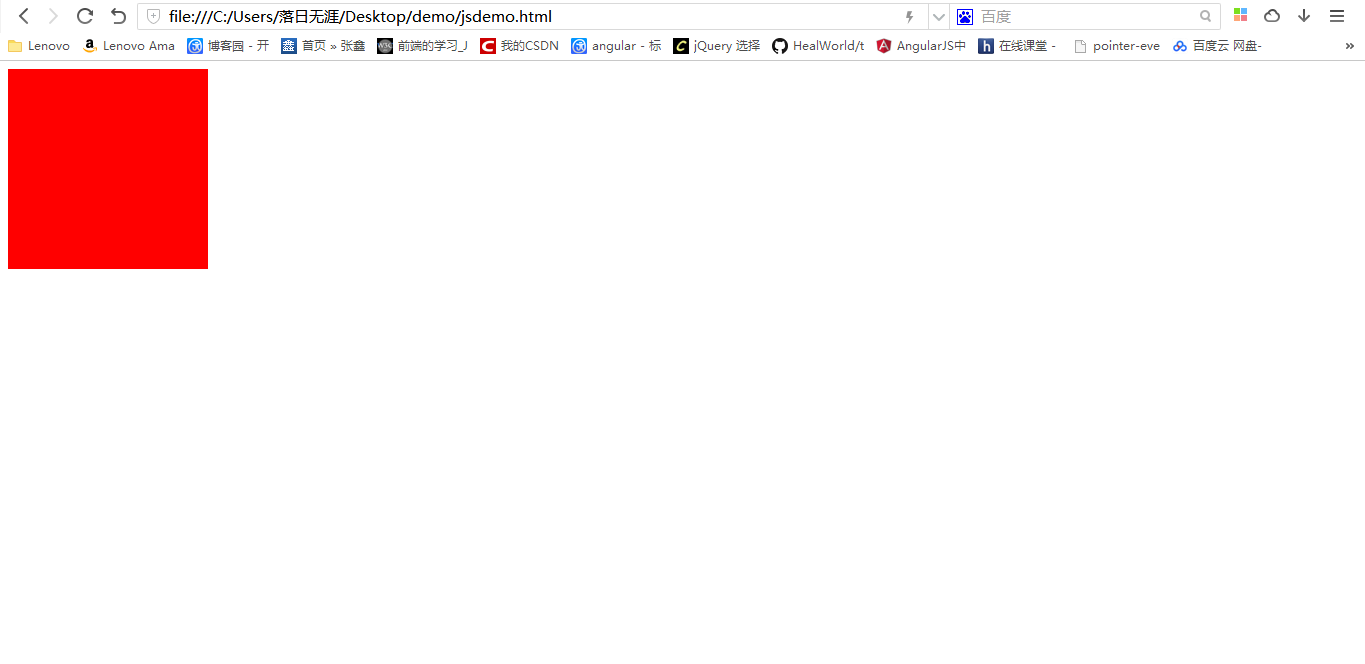首先,我们知道document.body指向的就是body元素,如此,我们就可以以document.body来获取body的大小。何以知之?如下代码:
var body = document.querySelector('body'); console.log(body == document.body);
结果显示的是true。
同样的document.documentElement指向的是html元素。
html代码如下:
<div id = 'div' style = '200px;height: 200px;background: red;'>
</div>
如图效果:

1.获取html的大小
如下代码:
var html = document.querySelector('html');
// 获取html元素的宽度 console.log("html-" +document.defaultView.getComputedStyle(html,null).width);
// 获取html元素的高度 console.log("html-height:" + document.defaultView.getComputedStyle(html,null).height);
结果显示:html-1366px,html-height:216px
2.获取body的大小
代码如下:
console.log("clientWidth:" + document.body.clientWidth);
console.log("clientHeight:" + document.body.clientHeight);
结果显示:body-1350px,clientHeight:200。
3.使用能够window.innerWidth获取
代码如下:
console.log("innerWidth:" + window.innerWidth);
console.log('innerHeight:' + window.innerHeight);
结果显示:innerWidth:1366,innerHeight:608
从以上的实验,可以知道,使用window.innerWidth/window.innerHeight获得的绝非是有些人所说的html的大小。
首先从width来看,为什么可见window.innerWidth和html的宽度是相等的。但是问什么body的width却是比二者都小呢?
其实答案很简单,因为body天生就有margin,不信的话,我们把body染色,代码如下:
html.style.backgroundColor = 'white';
body.style.backgroundColor = 'red';
之所以第一行给了html的背景色。其深入原因请见张大神的对html与body的一些研究与理解。效果如图:
body的margin未修改:

body的margin修改后:

那么滚动条是否会对三者的宽度有什么影响呢?
假如我们使浏览器增加一个垂直的滚动条。
三者的宽度如下(此时body的margin为0):
html-1349px,body-1349px,innerWidth:1366。
可见html是不把滚动条的宽度算在内的。而innerWidth是把滚动条的宽度算在内的。
然后我们再来看height的大小。首先是不出现滚动条的情况(为便于实验,此时body的margin设置为0)。
html-height:200px,body-height:200px,innerHeight:608
这种情况下,html和body的高度是一致的,就是我们所设置的div的高度。而innerHeight则是不一致的。高了很多。
而当出现滚动条的时候(将div的高度设置为2000px,结果如下:
html-height:2000px,body-height:2000px,innerHeight:608。此时可以看到,html和body的高度会随之改变,但是innerHeight依旧没有改变。
总结
最后我们就知道了,一般情况下,html和body的宽高都是相等的,除非是body的margin的影响。其宽高不包括滚动条。而innerHeight和innerWidth代表的永远是窗口的大小,窗口变大,他们的值就会变大,窗口变小,他们的值也就会变小,而且它的值包括滚动条的宽度,有可能比body和html的值大,也可能小。完全在于body中的元素的尺寸。所以在我看来,因为innerWidth存在兼容性问题,所以无法有个方法能够兼容所有浏览器获得窗口的大小,主要是窗口的高度不能够获得。